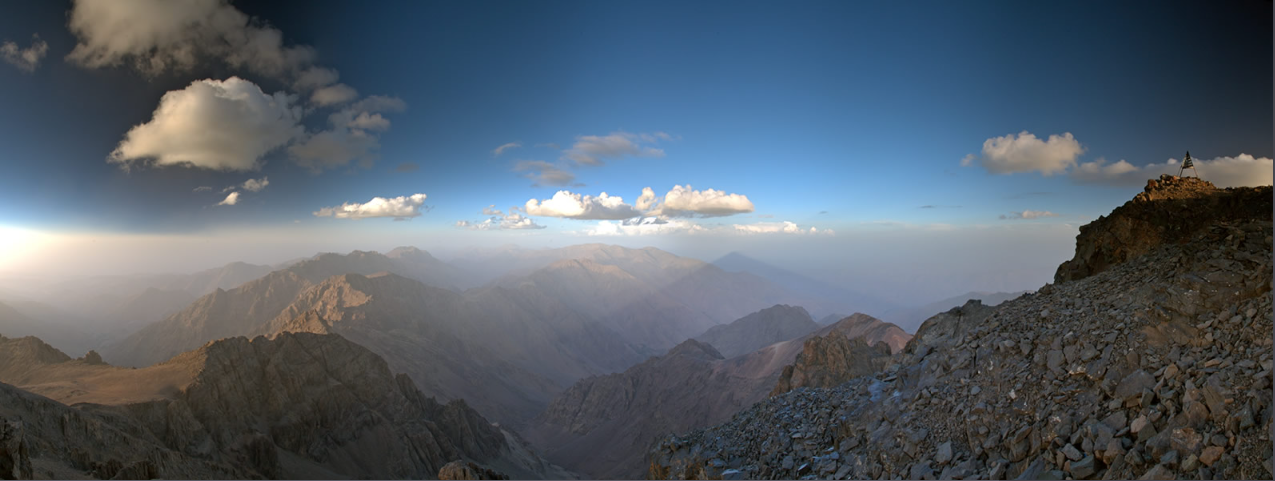Mount Toubkal Shadow & Sky Polarization, Morocco - OPOD
Mount Toubkal Shadow & Sky Polarization, Morocco - OPOD
The mesmerizing phenomenon captured in the photographs above showcases the enchanting play of light and shadow on Mount Toubkal, the highest peak in the Atlas mountain range of Morocco. Standing tall at an elevation of 4,167 meters, this majestic mountain casts a triangular shadow that stretches for miles across the hazy air. In addition to the captivating shadow, the wide expanse of sky above exhibits alternating bands of light and dark. Let's delve deeper into the fascinating science behind this atmospheric optics phenomenon.
When we observe the triangular shadow cast by Mount Toubkal, it is important to note that we are not witnessing a projection onto a distant screen or object. Instead, our gaze extends along the column of unlit air that stretches from just inside the upper edge of the shadow. This column gradually disappears into a point, similar to how a road or railway tracks vanish into the distance. It is this unique perspective that gives rise to the illusion of a perfectly triangular shadow.
To better visualize this concept, imagine a colossal cube measuring four miles on each side placed on the Earth's surface, casting a shadow. As the shadow extends for hundreds of miles, it maintains its square cross-section. However, when we stand on top of the cube and look along the shadowed air, it appears to converge into a point, resulting in the triangular shape that captivates our senses. Moreover, if we were to hang partially down one side of the cube and observe, we would notice an upward spike within the shadow.
In capturing these stunning photographs, a polarizing filter was employed to enhance the visual effect. The blue sky, being most strongly polarized at a 90° angle from the sun, manifests as dark regions positioned 90° on either side of the antisolar point. The antisolar point corresponds to the tip of Mount Toubkal's shadow. This polarization of the sky adds an extra layer of intrigue to the overall scene, heightening the contrast between the dark and light areas.
The interplay of light and shadow on Mount Toubkal serves as a captivating reminder of the wonders of atmospheric optics. This natural phenomenon, occurring under specific lighting conditions, offers a glimpse into the intricate mechanisms at play in our atmosphere. As we marvel at the ghostly triangular shadow and the polarized sky above, we are reminded of the myriad ways in which light interacts with our surroundings.
In addition to its aesthetic appeal, this atmospheric optics phenomenon also provides valuable insights for scientific research and exploration. By studying the behavior of light in different atmospheric conditions, scientists can gain a deeper understanding of the complex interactions between sunlight, air particles, and various atmospheric components. Such research contributes to advancements in fields like meteorology, climatology, and even astronomy.
As we continue to uncover the mysteries of atmospheric optics, phenomena like the Mount Toubkal shadow and sky polarization serve as a testament to the immense beauty and scientific intricacies present in our natural world. By capturing these moments of ephemeral wonder, we not only indulge our senses but also deepen our understanding of the forces that shape our environment.
So, next time you find yourself gazing at a stunning sunset or observing intriguing patterns of light and shadow, take a moment to appreciate the remarkable science behind these phenomena. The interplay of light and atmosphere offers endless opportunities for exploration and discovery, reminding us of the ever-present marvels that surround us in our daily lives.

Mount Toubkal Shadow
Panorama by Arnaud Besancon (photography) from near the summit of the 4167m high Moroccan mountain. A ghostly triangular shadow bisects the scene. The wide sky is alternately light and dark. Scroll right for the large view.
Image ©Arnaud Besancon, shown with permission

The mountain, lit by a low sun, casts its shadow for tens of miles through the hazy air. The peak, the highest of the Atlas range, is certainly not triangular yet its shadow is almost perfectly so.
We are not seeing a shadow projected onto some distant screen or object. We are instead looking along the long column of unlit air from just inside its upper edge. The column disappears to a point just as a road or railway tracks do so in the far distance.

Imagine a giant cube, 4 miles on each side, sat on the Earth and casting a shadow.
The shadow retains a square cross section for perhaps a hundred miles.
Now stand on the top of the cube and look along the shadowed air. It will disappear to a point and the shadow looks triangular.
Hang partly down one side to see an upward shadow spike.

A polarizing filter was used. Blue sky is most strongly polarized 90° from the sun. This shows in the panorama as dark regions 90° each side of the antisolar point marked by the tip of the mountain shadow.
Note: this article has been automatically converted from the old site and may not appear as intended. You can find the original article here.
Reference Atmospheric Optics
If you use any of the definitions, information, or data presented on Atmospheric Optics, please copy the link or reference below to properly credit us as the reference source. Thank you!
-
<a href="https://atoptics.co.uk/blog/mount-toubkal-shadow-sky-polarization-morocco-opod/">Mount Toubkal Shadow & Sky Polarization, Morocco - OPOD</a>
-
"Mount Toubkal Shadow & Sky Polarization, Morocco - OPOD". Atmospheric Optics. Accessed on November 26, 2024. https://atoptics.co.uk/blog/mount-toubkal-shadow-sky-polarization-morocco-opod/.
-
"Mount Toubkal Shadow & Sky Polarization, Morocco - OPOD". Atmospheric Optics, https://atoptics.co.uk/blog/mount-toubkal-shadow-sky-polarization-morocco-opod/. Accessed 26 November, 2024
-
Mount Toubkal Shadow & Sky Polarization, Morocco - OPOD. Atmospheric Optics. Retrieved from https://atoptics.co.uk/blog/mount-toubkal-shadow-sky-polarization-morocco-opod/.